Driving Through the Pouring Rain: How to Plan, Prepare and Adapt America’s Transportation Networks for Climate Change

By Lisa Dickson, PG, and Indrani Ghosh, PhD
On Sept. 24, 2014, President Obama told a landmark global-warming summit that the United States stands ready to make serious commitments to tackle climate change. Earlier in the week, U.S. Treasury Secretary Jacob Lew said that the United States must act now on climate change to avoid economic hardships that will grow from inaction.
One of the many ways that climate change will impact the economy is by causing disruptions to America’s rapidly aging transportation systems. With U.S infrastructure achieving a barely passable D+ grade by the American Society of Civil Engineers (ASCE), any additional stressors may cause the entire system to literally and figuratively buckle. The challenge, therefore, is to translate the theory of climate change into implementable practices that consider the most critical assets in the midst of an uncertain future.
Snow, Rain, Heat, Floods
At the center of the problem is how transportation networks–including rail, surface, air and marine–were originally engineered. In the United States, transportation systems have been typically designed with a 50-year lifespan and to withstand local weather and climate. For example, bridges often are designed to withstand 100-year storms (a storm so massive that there’s a 1-percent chance of it happening each year). While there were short-term variations in climate and weather, there was no overall increase in severity when viewed on a grander scale. The 100-year storm remained a 100-year storm.
However, due to climate change, historic events no longer are a reliable predictor of future impacts. In fact, 100-year events are occurring with more frequency. According to climate scientists, Hurricanes Katrina and the Perfect Storm (the combination of the 1991 Nor’easter and Hurricane Grace, which caused more than $200 million in damage and killed 13 people) were considered 100-year storms–even though they occurred within a seven-year interval.
Simply put, climate change is projected to increase the frequency and intensity of extreme weather events. Heat waves likely will be more severe, sea-level rise likely will amplify storm surges in coastal areas, and storms such as hurricanes and tornados likely will be more intense.
Global climate change and its impacts are a real and present threat to all transportation networks.
Other climate-change-related events (including fluctuations in rain, drought and cold/heat patterns) have the potential to impact transportation networks. For example, Winter Storm Pax (dubbed Snowpocalypse 2014) caused a fifth of U.S. Governors to issue “States of Emergencies,” 6,500 flights to be cancelled and more than 80,000 drivers to call for assistance in a 24-hour period in New York alone. Extreme rainfall events have the potential to flood subways, railways and airports. Roadway connections may be inaccessible because of breeched culverts and pooling of water in areas with inadequate drainage. Any one of these consequences, let alone the combined force, has the ability to significantly impact transportation infrastructure.
To plan and respond appropriately to challenges associated with climate change, transportation agencies must know what they can expect. Because owners, operators and scientists alike can’t predict the exact impacts of climate change, scientists have developed climate models to project plausible scenarios for the coming century and beyond.
Step 1: Establish climate scenarios and areas of focus
The first step to a solid climate response is to develop climate-change projections and scenarios, which take into account various data points, including scientific projections, planning horizons (how far out an organization is willing to plan), greenhouse-gas (GHG) emission scenarios and other relevant socio-economic and development information. The release of the National Climate Assessment provides information for various locations across the United States and can serve as a guide for expected changes. In addition, there is a growing literature of regional and local climate assessments that can be used to set baselines.
If climate-change projections are unavailable, transit authorities also can turn to academic partners to model regionalized climate projections. By working with academia, owners and operators can model anticipated climate-change scenarios–from least to most affected–to ensure that the organization understands the risk to its assets.
Looking at potential risks by mode of transportation, the following is found:
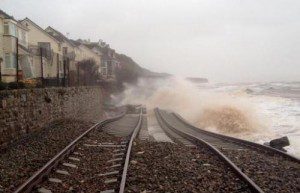 Rail
Rail
- High temperatures can cause rail tracks to expand and buckle, leading to speed restrictions and track repairs.
- Colder temperatures and heavy rainfall may lead to delays and disruptions. For example, on Jan. 26, 2014, two freight trains derailed in Caledonia, Wis., after unseasonably cold weather caused a switch to malfunction.
- Coastal railways and subways may be subjected to inundation from sea-level rise and storm surges.
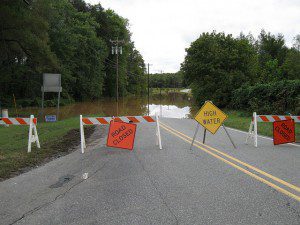 Roadways
Roadways
- Higher temperatures may cause pavement to soften and expand, creating rutting and potholes in high-traffic areas and bridge joints.
- Heat waves and humidity may limit construction activities, increasing the cost of building and maintaining roadways. However, certain areas may experience cost savings from milder winters and reduced snowfalls.
- Flooding and extreme snow events may shorten the life expectancy of highways and roads, requiring more-frequent repairs and rebuilding.
 Aviation
Aviation
- Extreme heat may cause airplanes to face cargo restrictions, flight delays and cancellations.
- Increased floods, sea-level rise, storm-surge inundation and rain may force entire airports to close or cause significant damage to facilities, including airstrips.
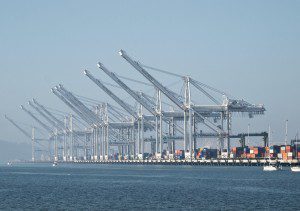 Marine
Marine
- Ports and infrastructure may need to be raised and/or hardened to accommodate higher tides, sea-level rise and storm surges
Step 2: Assess Impacts
After the projections have been evaluated and the critical assets identified, stakeholders should work together to conduct vulnerability and risk assessments. The assessments evaluate the susceptibility of individual assets based on climate projections and combine that data with the probability and consequence of the climate event occurring. The resulting data identifies and prioritizes the most at-risk assets.
Vulnerability to climate change is expressed as a function of exposure, sensitivity and adaptive capacity. Exposure, in this context, refers to the extent to which a system encounters a specific climate-change impact. For example, an airport located adjacent to a hurricane-impacted coastal waterway would need to plan for more severe storm events with higher storm surges, in addition to increased sea levels. Further, airports in areas where hurricanes have not historically made landfall may need to consider whether they are a potential future threat.
Sensitivity is the degree to which the functionality of a system is affected by a specific climate-change impact (whether directly or indirectly), and adaptive capacity is a measure of redundancy within the given system (e.g., back-up power supply). Cost and feasibility often are key factors in determining the adaptive capacity of a system.
Coupled with the vulnerability assessment, risk assessments can help develop location and mode-specific hazard-mitigation plans. Risk assessments identify and analyze the most-vulnerable elements and rank assets based on probability of occurrence and consequence of impact.
A risk assessment includes the vulnerability of the asset (e.g., how will it fare in the midst of increased flooding or temperatures) and the consequence of its failure. Part of the difficulty in risk management is that the potential loss and probability of occurrence can be difficult to measure, with a wide margin of error. Risk with a large potential loss and a low probability of occurrence often is treated differently from one with a low potential loss and a high likelihood of occurrence. In theory, both scenarios are of nearly equal priority, but in practice, the priorities can be difficult to manage when faced with the scarcity of resources–especially time in which to conduct the risk-management process
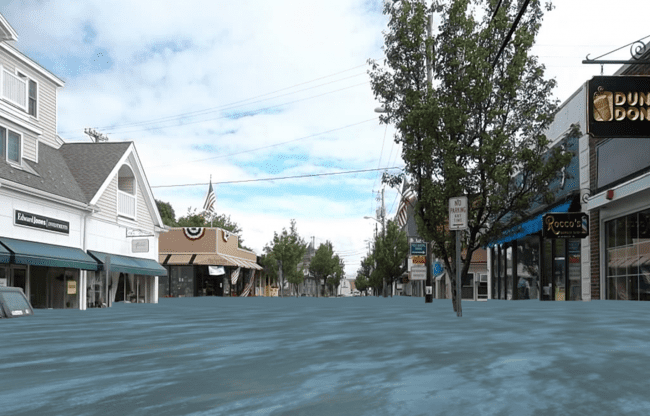
A 3-D visualization can help citizens understand the impact of sea-level rise, as projected on this business district with a street-level view. Image courtesy of Kleinfelder.
Step 3: Long-term planning
There are three broad categories of overall adaptation strategies: 1) maintain and manage, 2) abandon, or 3) strengthen and protect existing infrastructure. It’s important to note that adaptation strategies must be based on site-specific impacts, which may be further complicated by the realities of time, finances and politics. Choices will have to be made about what to protect, what to abandon and what level of risk they are willing to accept.
Strategies for maintaining and managing climate-change impact can be fairly straight forward and may include moving vehicles and other mobile assets out of harm’s way (for storms), preventing water incursion, improving drainage maintenance, increasing pumping capacity, and strengthening and raising bridges.
Conversely, the abandonment approach often is unrealistic, as the financial, economic, social and environmental consequences may make this approach unworkable in the short term. This is especially true with respect to port infrastructure.
Due to climate change, historic events no longer are a reliable predictor of future impacts.
For most, learning to live with climate impacts will be the most-effective approach. Strategies for responding to high heat include the use of shade shelters, efficient air conditioning, heat-resistant materials, and/or heat-management plans for worker and customer safety. For railways, engineered solutions to storms could include moving mechanical, electrical and other critical systems to confirmed dry ground or placing them on top of existing platforms to ensure that they continue to be operational during an inundation event. Operable parts, such as railroad turnouts, can be designed to be triggered by water, such as storm surges.
Other transit systems, like airports, could add plantings and retaining walls, which would act as protective reefs and slow or divert storm surges away from critical assets. Pump ventilators also could be built into an airport, which would return excess water to the sea while mimicking the effects of tidal exchange. These mechanisms could be designed to operate autonomously, using a system of sensors and smart software.
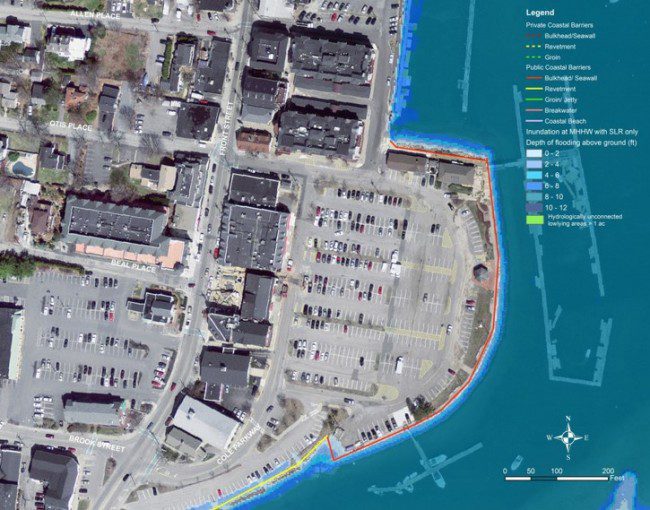
The inner harbor of Scituate, Mass., is shown under normal conditions.
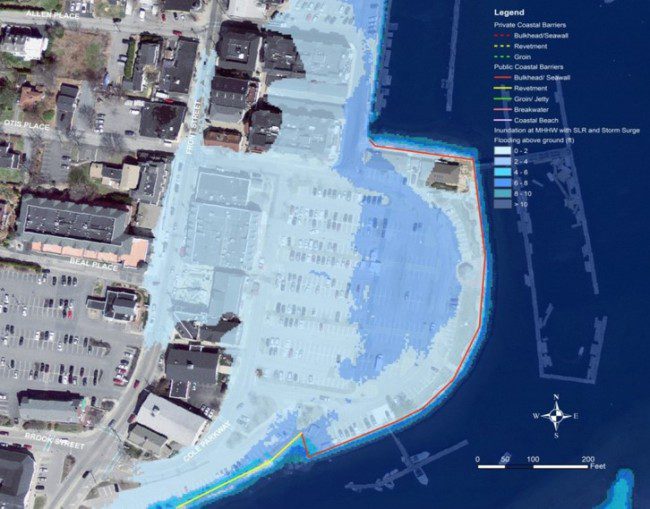
Here the same inner harbor of Scituate, Mass., is shown with resulting flooding from a Category 1 Hurricane. Detailed models of climate-change effects help local planners make better decisions.
Moving Forward
Global climate change and its impacts are a real and present threat to all transportation networks. In response, owners and operators should start preparing for what lies ahead—likely higher sea levels, increased flooding events and higher temperatures. This will require an integrated approach in which leading-edge science is translated into practical solutions for near- and longer-term planning horizons. Teaming with climate-risk experts will allow transportation agencies to assess vulnerability, identify the most at-risk structures, and develop cost-effective preparedness actions that can be integrated into maintenance and capital investment plans to provide for continuity in the face of climate change.
Author Bios: Indrani Ghosh, PhD, is the sustainability team leader for the Northeast at Kleinfelder, specializing in modeling climate-change impacts; e-mail: ighosh at kleinfelder.com. Lisa Dickson, PG, is the vice president of Sustainability at Kleinfelder, with expertise in regulations and financial markets related to carbon and renewable energy as well as risk assessment as it relates to sustainability and climate change; e-mail: ldickson at kleinfelder.com.


